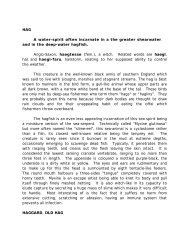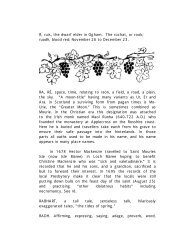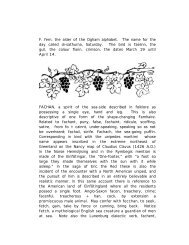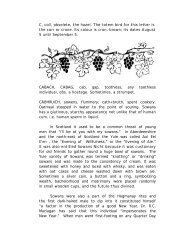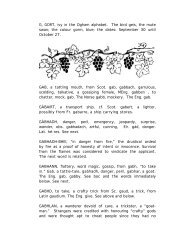L, luis, the mountain ash in the Ogham. Confers ... - Rodney Mackay
L, luis, the mountain ash in the Ogham. Confers ... - Rodney Mackay
L, luis, the mountain ash in the Ogham. Confers ... - Rodney Mackay
Create successful ePaper yourself
Turn your PDF publications into a flip-book with our unique Google optimized e-Paper software.
<strong>the</strong> Men <strong>the</strong> Maid's so that each of <strong>the</strong> young Men lights upon<br />
a girl, and each of <strong>the</strong> Girls upon a young man... each hav<strong>in</strong>g<br />
two Valent<strong>in</strong>es; but <strong>the</strong> man strikes faster to <strong>the</strong> Valent<strong>in</strong>e<br />
to whom he has fallen"These traditions came to America,<br />
although <strong>the</strong> conservative Puritans of New England objected,<br />
say<strong>in</strong>g: "No lad shall attend a mark on <strong>the</strong> fourteenth of<br />
February." After a three year sea-voyage, Capta<strong>in</strong> James<br />
Kemble kissed his wife <strong>in</strong> a public place (February 14,<br />
1764) and was sentenced to two hours <strong>in</strong> <strong>the</strong> stocks for<br />
sett<strong>in</strong>g a bad example.<br />
LATHEAN ARAIDH, <strong>the</strong> special days; araidh, traditional, old,<br />
superannuated, old-f<strong>ash</strong>ioned, antique, ancient. Related to<br />
ard, high, lofty. The quarter-days of Liughnasad, Samha<strong>in</strong>,<br />
Imbolc and Beltane.<br />
While most Europeans celebrated Midsummer Eve or<br />
Midsummer Day with a great fire, <strong>the</strong> Celtic people took<br />
little notice of <strong>the</strong> sun when it was highest <strong>in</strong> <strong>the</strong> sky,<br />
sav<strong>in</strong>g <strong>the</strong>ir energies until <strong>the</strong> night of October 31. They<br />
recognized two seasons: summer and w<strong>in</strong>ter, demarcated by<br />
May Eve and Samha<strong>in</strong>n Eve. These dates are unrelated to<br />
astronomical events. There are a few places <strong>in</strong> central<br />
Europe where <strong>the</strong> year is bisected as was is <strong>in</strong> ancient<br />
nor<strong>the</strong>rn Scotland. In this cattle-herd<strong>in</strong>g places, May Day<br />
was celebrated along with Samha<strong>in</strong>n.<br />
Beltane, or May Eve was much like Samha<strong>in</strong>n its<br />
essentials. Both holidays saw mummers mak<strong>in</strong>g <strong>the</strong> rounds,<br />
extort<strong>in</strong>g c<strong>ash</strong>, or k<strong>in</strong>d, for a day-long feast to take place<br />
dur<strong>in</strong>g <strong>the</strong> daylight hours There was "first-foot<strong>in</strong>g" and a<br />
dampen<strong>in</strong>g of hearth fires so that <strong>the</strong>y might be rek<strong>in</strong>dled<br />
from "new-fire".<br />
Of <strong>the</strong> two feasts, that held on Samha<strong>in</strong>n Eve was <strong>the</strong><br />
more important s<strong>in</strong>ce <strong>the</strong> Celts dated <strong>the</strong>ir year from it<br />
ra<strong>the</strong>r than from Beltane. On <strong>the</strong> Isle of Man, where Celtic<br />
lore had a long battle aga<strong>in</strong>st Saxon tales and myths, <strong>the</strong><br />
first day of November was regarded as New Year's Day<br />
through <strong>the</strong> last century and <strong>the</strong> first quarter of <strong>the</strong> current



